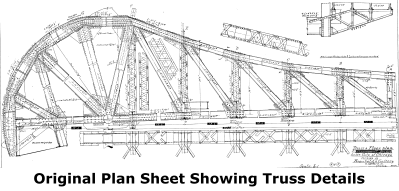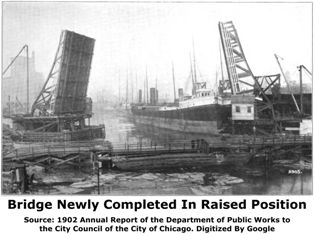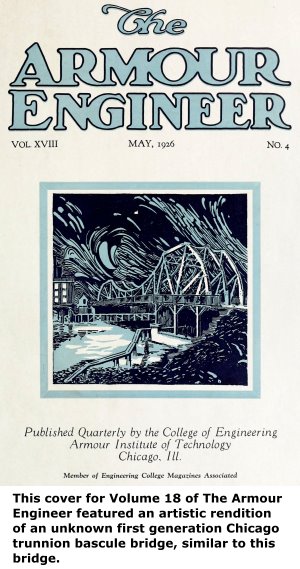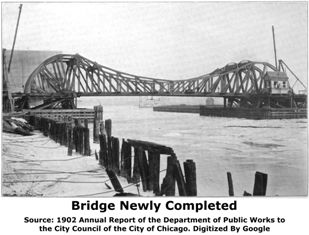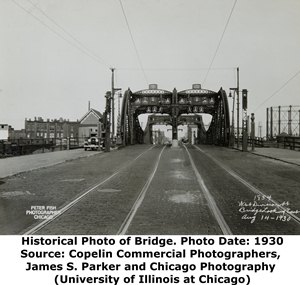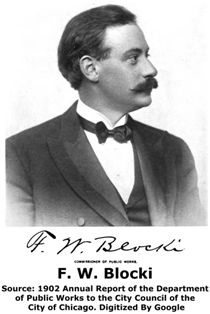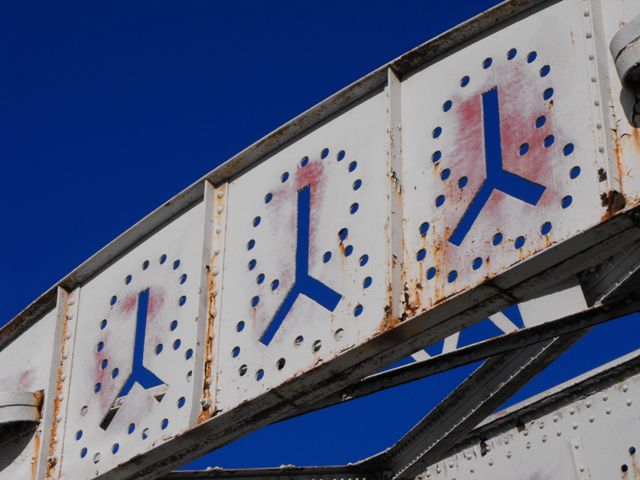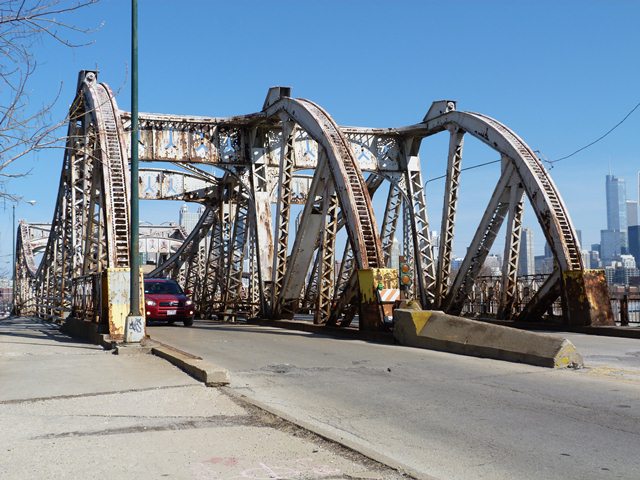We Recommend:
Bach Steel - Experts at historic truss bridge restoration.
BridgeHunter.com Phase 1 is released to the public! - Visit Now
Division Street North Branch Canal Bridge
Division Street Eastern Bridge
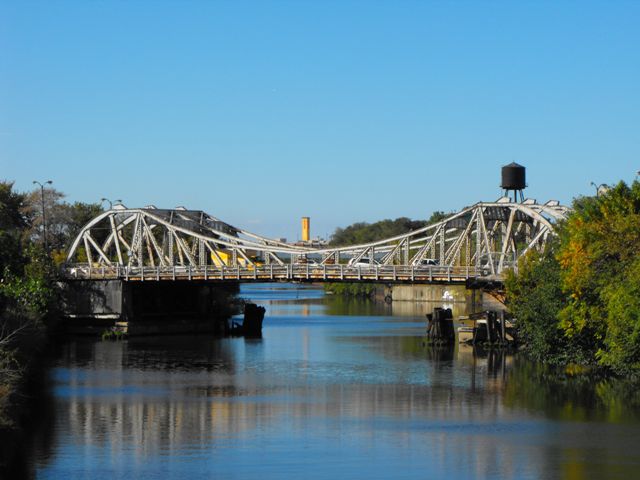
Primary Photographer(s): Nathan Holth
Bridge Documented: August 12, 2006, October 2010, September 10, 2012, and April 14, 2013
Chicago: Cook County, Illinois: United States
Metal Rivet-Connected Pratt Through Truss, Movable: Double Leaf Bascule (Fixed Trunnion) and Approach Spans: Metal Stringer (Multi-Beam), Fixed
1904 By Builder/Contractor: Roemheld and Gallery and Engineer/Design: City of Chicago
1992
173.0 Feet (52.7 Meters)
260.0 Feet (79.2 Meters)
39 Feet (11.89 Meters)
1 Main Span(s) and 4 Approach Span(s)
16601526637

View Information About HSR Ratings
Bridge Documentation
This bridge no longer exists!
This bridge's song is:
View Archived National Bridge Inventory Report - Has Additional Details and Evaluation
View Historic American Engineering Record (HAER) Documentation For This Bridge
HAER Data Pages, PDF
View Original Plans For This Bridge
This extremely significant historic bridge was demolished Summer 2014!
Summer 2014 Demolition Comments
This bridge is one of the most historic bridges in Chicago. With its decorative portals, it is also unique. Despite this the bridge has not been maintained like the historic bridges in downtown Chicago. The bridge has become so deteriorated that the city is now planning to demolish and replace the bridge with a temporary bridge in Summer 2014, until a project to build a new permanent bridge can be realized.
HistoricBridges.org has several concerns with this. First, this project as proposed results in the loss of a highly significant and unique historic bridge in Chicago. This could and should have been avoided. Rather than demolish this historic bridge, the trusses could be carefully lifted off the canal, allowing for the temporary bridge to be put in place. Then, the trusses of this bridge could be shipped off to a shop where they could be carefully rehabilitated, with areas deteriorated beyond repair being replaced in kind. Then, several things could happen. The trusses could be reinstalled over the river as a rehabilitated permanent bridge for Division Street. Alternatively, a new superstructure could be built over the canal, and the trusses could be placed on top of the replacement bridge as a decorative element. This sort of process can be observed with the Washington Avenue Bridge in Minneapolis. Another option would be to reuse the rehabilitated trusses in a new location, either on a road for vehicular use, or on a trail for pedestrian use. Finally, at the absolute very least these trusses should be salvaged, repainted, and placed in a park setting in the Chicagoland area as a non-functional interpretive exhibit.
Given the significance of this bridge and all the preservation options presented above, the planned demolition of this bridge's beautiful trusses is both highly disappointing and unnecessary. This bridge represents the beginning of Chicago's bascule bridge heritage and it deserves more than to be cut up, shipped to China, melted down, and turned into soup cans!
About This Bridge
Crossing the North Branch Chicago River Canal onto or off of Goose Island, this is one of the very first highway bascule bridges built in Chicago, constructed just a couple years after Cortland Street. Given the influence that Chicago's development of the bascule bridge had on bridge construction nationwide, this prototypical example of a Chicago type trunnion bascule bridge is nationally significant and its preservation should be given a paramount level of priority.
Roemheld & Gallery of Chicago were both the designers and builders of the bridge. This bridge is similar to bridges like Cortland Street, but it has one very unusual and distinctive characteristic which sets it aside from these other bridges. The overhead sway/portal bracing for this bridge is composed of simple plate steel with decorative designs on them that includes an upside-down "Y" design with a circle around it that is used in Chicago to refer to the three branches of the Chicago River. The symbol became an officially designated symbol appearing in Chicago's municipal code as the "Municipal Device." Easy to miss unless you are looking for it, the symbol can be found on buildings and structures throughout the city including on a few other bridges. This Division Street Bridge however is the only bridge in the entire city that includes this design in its overhead bracing. The bridge is different from the other early bascule bridges including the bascule bridge in sight of this one also on Division Street, which have a more intricate network of built-up sections of v-laced and latticed steel for bracing. The plates with the Municipal Device symbol on this bridge are an interesting and decorative element that adds a lot to the bridge.
Some authors and historians have criticized the earliest bascule bridges including this one as lacking aesthetics. And while indeed, bridges like this may have not been in keeping with the aesthetic desires of the time in which they were built, two things are clear today. First, in today's world of simplistic bridges, bridges such as this do have aesthetic value in the context of the modern world. The complex trusses made up of equally complex components like built-up beams with v-lacing and lattice offer an intricate geometric beauty that is not found in any form of modern bridge. The early bascule bridges of Chicago, like this bridge, have very tall trusses with overhead bracing, and this unavoidable design catches the attention of travelers and lets them know in no uncertain terms that they are crossing a bridge. This characteristic is lost on most modern bridges. In the context of the modern world, these elements have a positive effect on the aesthetic qualities of the road and location they serve. In the case of the Division Street bridge, the decorative designs found on the overhead bracing only add to the aesthetic qualities of the bridge. These designs are remnants of a different era of aesthetics, quite different from the type of aesthetics found on Chicago's bascule bridges that were built in the 1920s and 1930s for example. In the late 1800s, bridges were often metal truss bridges that lacked curved beams and did not have a very graceful design. This did not mean that the bridges were not beautiful or lacked aesthetic qualities, however. In this period, a more heavy reliance was placed on adornments like finials, portal cresting, and decorative builder plaques. Generally aesthetic enhancements to the actual bridge structure was often limited to the use of decorative bracing which might have attractive curved designs, or cutout shapes (like those found on the Division Street Bridge). The purpose of all these enhancements was to accent and decorate the bridges. In contrast, in the 20th Century, the use of concrete in bridge construction gave engineers the ability to create bridges that had graceful arches, with decorative elements cast directly into the concrete as well. Concrete also allowed for more streamlined and simplistic bridge designs. This along with general changes in architectural trends (like Art Deco) led to significant changes in what an "aesthetically pleasing" bridge was thought to be. This focus on streamlining, curves, and a generally graceful appearance is also evident in the later examples of Chicago bascule bridge. The Division Street Bridge thus appears at the end of one era of architecture and before the new era had really managed to take hold in Chicago.
The previous bridge at this location was also the first documented bridge at this location. It was built in 1870 and was a hand-turned iron/wood combination bridge built by Fox and Howard. It was 176 feet long and 29 feet wide.

![]()
Historic Bridges of Chicago and Cook County


Chicago and Cook County are home to one of the largest collections of historic bridges in the country, and no other city in the world has more movable bridges. HistoricBridges.org is proud to offer the most extensive coverage of historic Chicago bridges on the Internet.
General Chicago / Cook County Bridge Resources
Chicago's Bridges - By Nathan Holth, author of HistoricBridges.org, this book provides a discussion of the history of Chicago's movable bridges, and includes a virtual tour discussing all movable bridges remaining in Chicago today. Despite this broad coverage, the book is presented in a compact format that is easy to take with you and carry around for reference on a visit to Chicago. The book includes dozens of full color photos. Only $9.95 U.S! ($11.95 Canadian). Order on Amazon.
Chicago River Bridges - By Patrick T. McBriarty, this is a great companion to Holth's book shown above. This much larger book offers an extremely in-depth exploration of Chicago's movable highway bridges, including many crossings that have not existed for many years. Order Now Direct From The Publisher! or order on Amazon.
View Historic American Engineering Record (HAER) Overview of Chicago Bascule Bridges (HAER Data Pages, PDF)
Chicago Loop Bridges - Chicago Loop Bridges is another website on the Internet that is a great companion to the HistoricBridges.org coverage of the 18 movable bridges within the Chicago Loop. This website includes additional information such as connections to popular culture, overview discussions and essays about Chicago's movable bridges, additional videos, and current news and events relating to the bridges.
Additional Online Articles and Resources - This page is a large gathering of interesting articles and resources that HistoricBridges.org has uncovered during research, but which were not specific to a particular bridge listing.
This bridge is tagged with the following special condition(s): Unorganized Photos
![]()
Photo Galleries and Videos: Division Street North Branch Canal Bridge
Structure Overview
Original / Full Size PhotosA collection of overview photos that show the bridge as a whole and general areas of the bridge. This gallery offers photos in the highest available resolution and file size in a touch-friendly popup viewer.
Alternatively, Browse Without Using Viewer
![]()
Structure Details
Original / Full Size PhotosA collection of detail photos that document the parts, construction, and condition of the bridge. This gallery offers photos in the highest available resolution and file size in a touch-friendly popup viewer.
Alternatively, Browse Without Using Viewer
![]()
Structure Overview
Mobile Optimized PhotosA collection of overview photos that show the bridge as a whole and general areas of the bridge. This gallery features data-friendly, fast-loading photos in a touch-friendly popup viewer.
Alternatively, Browse Without Using Viewer
![]()
Structure Details
Mobile Optimized PhotosA collection of detail photos that document the parts, construction, and condition of the bridge. This gallery features data-friendly, fast-loading photos in a touch-friendly popup viewer.
Alternatively, Browse Without Using Viewer
![]()
2013 Additional Unorganized Photos
Original / Full Size PhotosA supplemental collection of photos that are from additional visit(s) to the bridge and have not been organized or captioned. This gallery offers photos in the highest available resolution and file size in a touch-friendly popup viewer.
Alternatively, Browse Without Using Viewer
![]()
2013 Additional Unorganized Photos
Mobile Optimized PhotosA supplemental collection of photos that are from additional visit(s) to the bridge and have not been organized or captioned. This gallery features data-friendly, fast-loading photos in a touch-friendly popup viewer.
Alternatively, Browse Without Using Viewer
![]()
Bumpercam: Eastbound Crossing
Full Motion VideoNote: The downloadable high quality version of this video (available on the video page) is well worth the download since it offers excellent 1080 HD detail and is vastly more impressive than the compressed streaming video. Streaming video of the bridge. Also includes a higher quality downloadable video for greater clarity or offline viewing.
![]()
Maps and Links: Division Street North Branch Canal Bridge
This historic bridge has been demolished. This map is shown for reference purposes only.
Coordinates (Latitude, Longitude):
Search For Additional Bridge Listings:
Bridgehunter.com: View listed bridges within 0.5 miles (0.8 kilometers) of this bridge.
Bridgehunter.com: View listed bridges within 10 miles (16 kilometers) of this bridge.
Additional Maps:
Google Streetview (If Available)
GeoHack (Additional Links and Coordinates)
Apple Maps (Via DuckDuckGo Search)
Apple Maps (Apple devices only)
Android: Open Location In Your Map or GPS App
Flickr Gallery (Find Nearby Photos)
Wikimedia Commons (Find Nearby Photos)
Directions Via Sygic For Android
Directions Via Sygic For iOS and Android Dolphin Browser
USGS National Map (United States Only)
Historical USGS Topo Maps (United States Only)
Historic Aerials (United States Only)
CalTopo Maps (United States Only)


